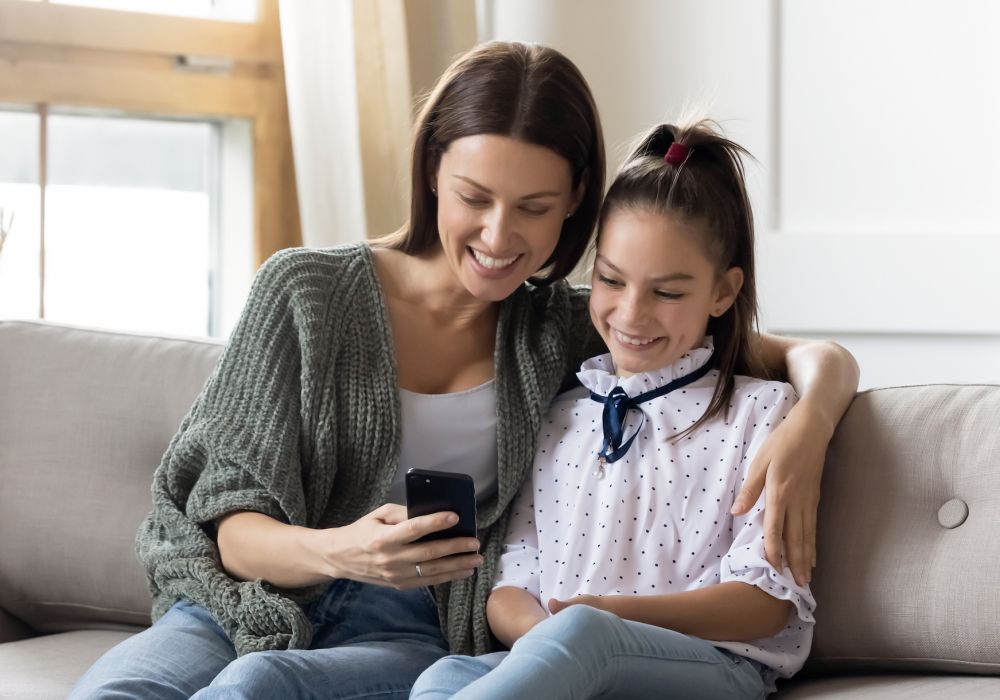Why the Cell Phone's Become a Back to School Essential

Reading time: 8 minutes
There are dozens of reasons parents – even grandparents – need technology to be able to connect to kids during the school day.
For starters there’s the matter of “forgotten classroom items.” You know, they call and beg you to drop what you’re doing to deliver … the homework they need now, the sports gear they’ll need later, the musical instruments the band instructor inspects daily, the egg they’re supposed to watch and care for like it’s a baby…
For forgotten items, they need a cell phone.
Then there’s the “I don’t feel well,” “My braces broke,” “They made us run in gym and now I think I have heat stroke” stuff. And of course there’s the “I forgot to tell you I’m going to a friend’s house after school," “I need to stay for rehearsal so my friend Cody will drive me home later,” and the inevitable “What’s for dinner? If it’s meatloaf, can I order pizza?” communications.
For all of these announcements and requests – and many others – kids need to have cell phones.
But that doesn’t mean you need to break the bank to get them one.
Get unlimited talk, text, and 2GB of data for $20 a month

Pure Talk is proud to offer you – and your student – plans starting as low as $20 a month for unlimited talk and text and 2GB of data. And even though our plans are budget-friendly, our service is priceless.
PureTalk is on the same 5G network – the most reliable network in the country – as Verizon, AT&T, and T-Mobile. The 5G network provides the best cell coverage at significantly greater speed and is more flexible, reliable, and secure than any network before it.
And speaking of kids, families of four who switch to PureTalk save $75 a month for an average of $900 a year. That’s a lot of money; money that can certainly go toward ordering pizza for your non-meatloaf loving student, fixing those braces, or paying for a spring break trip.
PureTalk's Money Back Guarantee
Just as importantly, PureTalk offers a risk-free, thirty-day money back guarantee. That means you have absolutely nothing to lose. Sign up and give us a try for one month. We know you and your student will love us. But if you don’t, simply cancel your service within thirty-days and we’ll return your money without any penalties.
Plus, with PureTalk, you can bring your phone and keep your phone number or choose from mobile phones from our terrific selection of the latest iPhones and Androids.
Things to know once your kids have cell phones.

Once your student has a cell phone it’s practically guaranteed that he or she will be glued to it, or at least attempt to be glued to it. It’s kind of understandable, particularly if they’ve waited a long time to get one.
So, it’s up to you to set boundaries and direct your student’s digital consumption. You should probably remind them that cell phones in school are best kept in their backpack but that educational apps are ok and might even be suggested by their teachers and school leaders. Cell phones can be a great learning tool and offer access to many educational apps that enhance student learning and educational productivity.
Cell phones in an emergency situation at school
The fear that parents will not be able to reach their children during an emergency, like school shootings, has fueled opposition to ambitious cellphone restrictions. Ken Trump, president of National School Safety and Security Services, cautions that cellphone communication during such an emergency can actually increase safety risks. "During a lockdown, students should be listening to the adults in the school who are giving life-saving instructions, working to keep them safe." Obviously, this is something you'll want to discuss with your student when they get a cell phone.
Following are a few ideas for managing your student’s screen time.
Limit the amount of time your student can be on his or her cell phone.
All kids – young ones, tweens, and teens – need boundaries and it’s up to parents to set them. Maybe allow them 15 minutes before they leave for school in the morning, half an hour before homework time after school, and an hour after their homework is completed in the evening to be on their mobile devices.
According to the experts at Action for Healthy Kids, bedrooms should be “no screen zones.” Kids who have TVs in their rooms tend to watch about 1.5 hours more TV per day than those who don’t. Move televisions, computers, tablets, etc. into shared family spaces. Designate one or more days per week as “screen-free” days, where physical activity, reading and spending quality time together are prioritized. Set firm limits for using screens. For example, no video games on school nights or no electronic devices an hour before bedtime. And turn off electronic devices during dinner. Make use of the time together to talk about the day.”
With students' mental health top of mind, many teachers, school leaders and state legislators have been pushing for tighter restrictions — saying that after decades of studying technology's grip on American kids and years of competing for students' attention, they've had enough.

Get into their business.
Know who your kids’ friends are, both online and off. Know their parents, if possible. And definitely know what social media platforms they’re on, what sites they go to on their cell phones, and exactly what they’re doing on those sites. It’s also an excellent idea to be friends with your child on whatever social media platforms they are on: Facebook, Instagram, Snapchat, and TikTok. This way you can keep an eye on the usernames of people who follow your child and also see if any of your child’s videos are being saved far too many times.
Disturbing usernames and videos that have been saved thousands of times are enormous red flags that require immediate parental involvement. Your student might not like being “friends” with you online, and you might hear, “You don’t trust me!” but stay strong. There are, sadly, lots of parents who wished they had known who their kids were interacting with and what sites they were on.
Set the example.
Consider ditching social media or limiting your own use to no more than 30 minutes a day. Your student may not follow your phone usage lead immediately but give it time and spend the time you would have been on your phone doing things with them and others in your community. Real life friendships offer deeper levels of well-being than any friendship struck up online and spending more time with your kids is always the best investment.

Have cellphone bans in certain areas.
No cell phones or tablets at the family dinner (breakfast and lunch, too) table and in restaurants. Same goes for family gatherings and social gatherings including things like church services. Keep televisions out of your student’s bedroom and resist the urge to have the television on as “background noise.” Create a for cell phones station in the kitchen or other easily accessible common area where cell phones and other electronic devices can be charged overnight.
If you don’t already have this kind of cell phone policy in place, it will take your kids time to get used to them but – hang in there. Studies show that the results of having such policies about cell phones are more frequent and better family time, better sleep, better eating habits, and better academic performance.
Talk to your child about the realities of online privacy.
Unfortunately, most teens – and even many adults – think that using a social media platform’s privacy setting means their words, photos, and videos are private. Far from it. Anything and everything your child posts instantly becomes part of his or her digital footprint – and anyone can access it. Colleges, future employers, clubs or associations they might one day like to join can and do find it all. And that includes photos sent while sexting. Your child might not post those images to a website or platform, but the mere act of sending them to someone means that photo is forever “out there,” unable to be deleted or removed and thus able to be found. Encourage your kids to think before they post or sext and to come to you if they make a mistake. Let them know that, while you don’t condone that kind of behavior, you will be there to help if necessary.
Talk to your child about online predators and sex offenders.
These bottom feeders are everywhere. Social media platforms. Chat rooms. Gaming sites. Websites designed to look like gaming sites or online stores, etc. They prey on kids who appear, by virtue of their posts, to be vulnerable. Depressed, lonely, feeling alienated, bullied, abused in some way – kids opening themselves up about these and other emotions are the siren call to sex offenders and sex traffickers. The best thing your child can do is not post these feelings anywhere online. Instead, encourage them to come to you to talk or, if they’re too embarrassed, to seek the counsel of a trusted adult.
In addition, the pros at Focus on the Family recommend keeping open communication between you and your child. “Let your children know that it’s safe for them to confide in you if they have questions or concerns — or if they’ve made a mistake in this area. Fearing an explosive reaction can keep a child from being open. All this to say, help from parents is most effective when it’s given with a balance of grace and truth.”
Screen time best practices for young children or grandchildren.
Communicate face to face.
Remember that little ones learn best by communicating face to face. Talking back and forth in a face to face conversation is critical for language development and learning to read social cues. They can’t get those skills from texting on their cell phones. Two-way communication is the key to strong language skills. And while in person is best, chatting with parents, grandparents, older siblings or far-flung family members via FaceTime or Zoom works too.
The importance of play.
On the weekends, during school breaks, and over summer vacation, set limits as to how much time your kids can be on their cell phones. Otherwise, frankly, they’ll be hunched over their digital devices scrolling away for hours at a clip. We know a woman who gives her kids an hour on their cell phones in the morning, another hour after lunch, and two hours in the evening to be on their phones or gaming systems whenever there’s no school. Other than those times, they need to be involved in unstructured playtime. That can be running around outside, reading, writing, pursuing a hobby, practicing a musical instrument, daydreaming, etc. All of these activities – including daydreaming – stimulate creativity. If you have very young children or grandchildren, daily playtime needs to be a priority.
Get in on their act.
Play video games with your children or grandchildren. Watch a show or movie with them. Doing these things promotes social interaction and bonding. It also gives you a chance to share your own life experiences and encourage good sportsmanship. So get down on the floor, grab a controller, and let the games begin. Your kids will think you’re the coolest.
Get unlimited talk, text, and 2GB of data for $20 a month with PureTalk!
Posted 9 months ago
